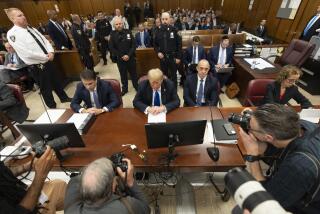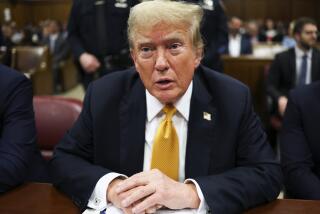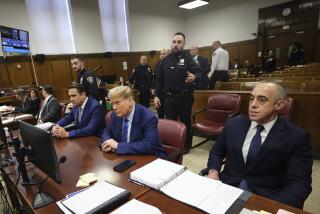Jurors Hint at Conviction for Andersen
- Share via
HOUSTON — Jurors in the Arthur Andersen trial asked the judge Thursday if they could convict the firm even if they couldn’t agree on which Andersen executive violated the law.
The question suggested that at least a bloc of jurors is leaning toward conviction. But U.S. District Judge Melinda Harmon did not give an answer, saying she would need to research case law on the issue.
Andersen lead attorney Rusty Hardin said the jury’s note, “on its face, would look to be discouraging” to the defense. But he said the jury’s question and subsequent requests for other testimony indicated jurors still are sorting through the evidence.
Jurors had resumed their deliberations Thursday after telling Harmon the day before that they failed to reach a unanimous decision. Harmon had read a special instruction, called an Allen charge, asking the panel to renew efforts to reach a verdict in hopes of avoiding a mistrial.
The panel raised the conviction question in a note to Harmon on Thursday morning.
“If each of us believes that one Andersen agent acted knowingly and with a corrupt intent, is it for all of us to believe it was the same agent?” the jury asked in the first of a series of notes. “Can one believe it was agent A, another believe it was agent B, and another believe it agent C?”
Andersen said federal courts already have settled the question in its favor, but prosecutors disagreed.
“As long as they agree on the bottom line, it isn’t necessary for them to agree on the same actor,” said Assistant U.S. Atty. Andrew Weissmann.
Hardin said, “They do have to unanimously agree that at least one person had corrupt intent.”
Several legal experts said there is no clear legal precedent, sending the case into uncharted territory.
Columbia University Law School professor John C. Coffee said the jury note indicates at least some jurors believe Andersen committed a crime but disagree on the individual responsible.
If Harmon rules that the panel has to agree that a single executive carried out the crime in order to convict, Coffee suggested, some jurors could change their minds to reach unanimity.
“The prosecution should be encouraged by the fact that it seems that the disagreement is the issue of who the guilty party is within the firm,” he said.
Under the law, a partnership such as Andersen can act only through its executives, or “agents.” In order to convict the firm, the jury must find that “one or more” executives “corruptly persuaded” others to destroy Enron-related files and also possessed the intent to conceal them from the Securities and Exchange Commission.
Prosecutors have identified four Andersen executives as the agents who acted to persuade others: in-house attorney Nancy Temple and Houston-based partners David B. Duncan, Thomas Bauer and Michael Odom.
Duncan, fired by the firm in January, has pleaded guilty to a separate obstruction charge and testified in the case. Temple and Bauer each invoked their rights against self-incrimination and refused to testify. Odom was not called as a witness by either side.
If the jury fails to reach a unanimous decision, a mistrial would be declared and prosecutors said they would retry the case.
Hardin said that earlier this week, as the jury’s deliberations stretched on, his team had “talked ourselves into” the possibility that they might obtain an acquittal in a case once considered by many to be unwinnable for Andersen. But Thursday, Hardin said he had begun to consider asking Harmon to declare a mistrial on the grounds that the jury has reached an impasse.
“It’s an option.... [It] doesn’t mean she’d grant it,” he said.
Jurors also sent out two notes asking to see a videotape exhibit and to have certain testimony read back to them by a court reporter.
The panel said it wanted to review a videotape of an Oct. 10 training session in which Odom encouraged executives to comply with the firm’s document-retention policy, which calls for discarding drafts and papers deemed unnecessary for Andersen’s final audit files.
Odom made the presentation to about 80 people, about 10 of whom worked on audits of Enron.
The jury also asked to hear again portions of the testimony of Duncan and Andersen partner Amy Ripepi.
At least six jurors scribbled furiously on notepads as the court reporter recited testimony from Ripepi, the head of Andersen’s accounting-specialist team, who said on the witness stand that she participated in a hastily arranged conference call Oct. 20 in which senior executives discussed a letter of inquiry that Enron had just received from the SEC. Ripepi said in-house lawyer Temple advised executives on the call to “follow the policy.”
The court is expected today to read Duncan’s testimony on a discussion he had in mid-October with former Enron Chief Accounting Officer Richard Causey about Enron’s third-quarter losses. The jury also is expected to hear Duncan’s testimony about an Oct. 23 conference call in which executives discussed Enron’s possible restatement of past earnings.
Harmon could rule on the crucial question asked by jurors when court resumes today.
Asked whether a ruling in favor of the prosecution would provide a solid basis for appeal, Hardin said, “The fact that we may have very valid points on appeal doesn’t do me much good right now.”
Times staff writer Jerry Hirsch contributed to this report.
More to Read
Inside the business of entertainment
The Wide Shot brings you news, analysis and insights on everything from streaming wars to production — and what it all means for the future.
You may occasionally receive promotional content from the Los Angeles Times.










